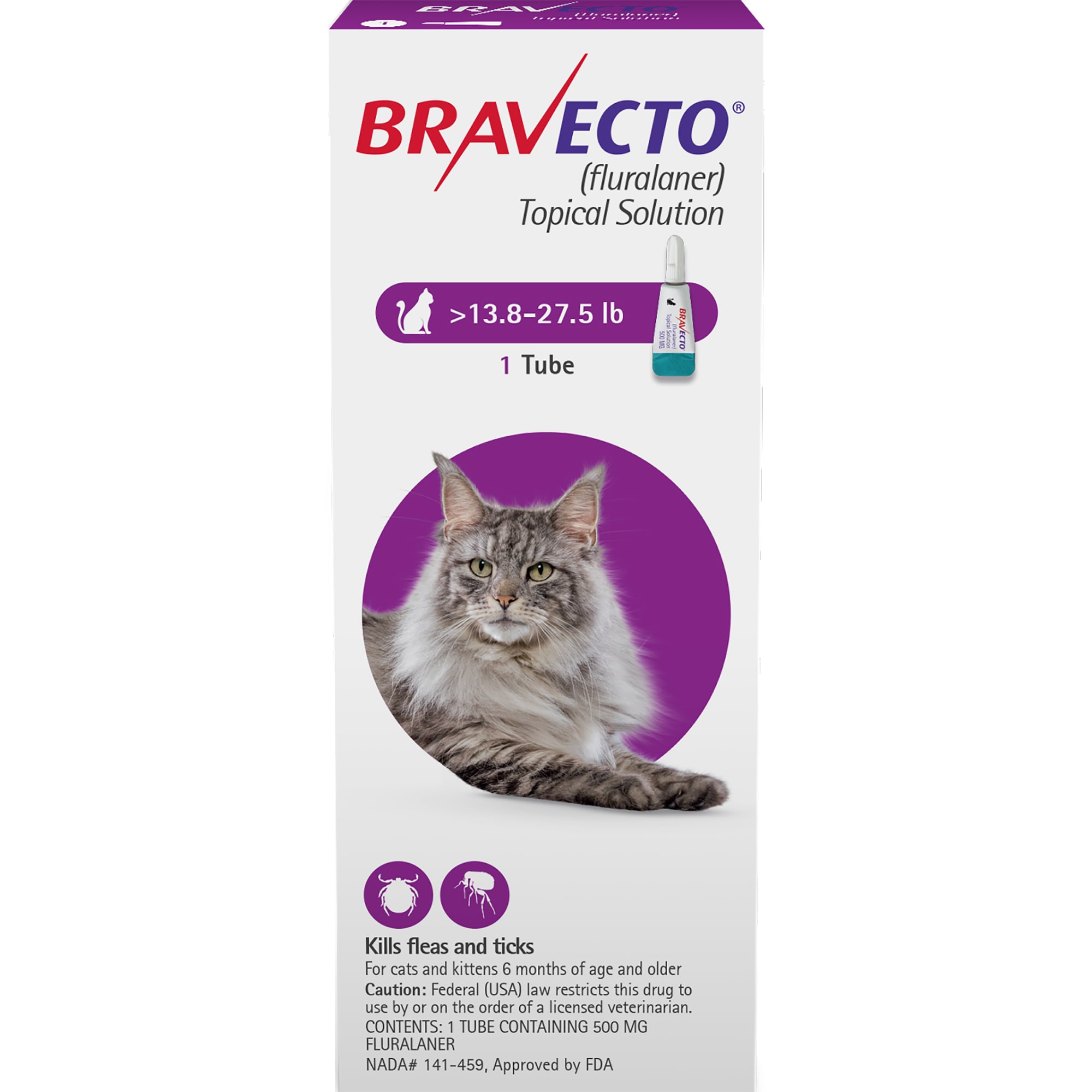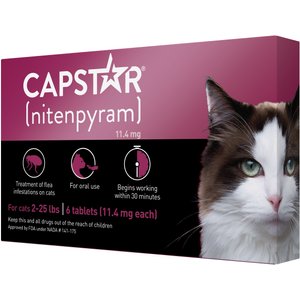- Active Ingredient(s): 60 mg Selamectin, 10 mg Sarolaner
- Doses: 3
- Size: 3 different cat sizes available (2.8-5.5 lbs, 5.6-11 lbs, 11.1-22 lbs)
The Best Flea Treatments for Cats, According to Veterinarians

Our evaluations and opinions are not influenced by our advertising relationships, but we may earn a commission from our partners’ links. This content is created by TIME Stamped, under TIME’s direction and produced in accordance with TIME’s editorial guidelines and overseen by TIME’s editorial staff. Learn more about it.
Fleas are bad news for your cat, and depending where your sympathies lie, they’re possibly even worse for you and your home. Unlike purchasing a cat litter box or even one of those fancy automatic cat feeders, an effective flea treatment can be tricky for the average pet owner to find. Instead, we consulted with a panel of veterinarians and pet experts to find out the best flea treatments for cats, along with other ways to get the jump on those pesky critters.

“This covers fleas, ticks, intestinal parasites, and ear mites,” says board-certified feline veterinarian Amber Carter, DVM, DABVP (Feline Practice), owner of CatVetLife and Ormond Cat Care Clinic. “I love the alcohol base as it dries really quickly. In an hour’s time you can’t even tell it was applied—that’s great for multi-cat households where cats may groom each other.”

Recommended for this list by Dr. Katy Nelson, senior veterinarian at Chewy, this medication provides 12 weeks of protection against both fleas and ticks. Bravecto also claims to kill all attached ticks in just 12 hours, compared to up to 48 hours with other treatments. Fleas, meanwhile, will be dispatched in eight hours.

“Capstar is great and starts killing fleas within 30 minutes,” says Carter. “It only lasts for 24 hours, but it’s great for getting a jump on killing the fleas.” The tablets can be given to your cat once a day, with or without food, and are 90% effective at killing fleas within just six hours.

For worms alone, Nelson suggests using Hartz UltraGuard Rid Worm Dewormer for Roundworms for Cats. If your unfortunate kitty is suffering from both fleas and worms, though, you can try this multi-use treatment, designed to kill off fleas, ticks, hookworms and roundworms, while preventing more of the same–plus heartworms—for up to two months.

Another of Nelson’s recommendations, NextStar Fast Acting, starts working to kill both fleas and ticks in just 15 minutes. As well as preventing them from coming back for up to a month—including eliminating flea eggs—it also keeps other annoyances like lice and mosquitoes away. It’s waterproof, too, so if your cat is one of those rare water-loving kitties, they’ll still be protected.

“I would not consider any other flea collar for cats [besides this],” says Carter. “They simply do not work well and their safety may be questionable.” Also chosen for this entry by Nelson, the Seresto flea collar starts working quickly and lasts for up to eight months, making it one of the simplest and longest lasting treatments on our list.

Carter’s earlier recommendation is available for cats in three weight classes, including the kitten-friendly 2.8-5.5 lb range (try not to “squee!” as you picture a kitty that tiny). Suitable for kittens once they’ve hit eight weeks, it kills fleas, ticks, ear mites, roundworms, and hookworms, and prevents fleas and heartworms.

If your cat could reasonably be described as a heckin’ chonk, Nelson advises the use of Advantage XD Large Cat Treatment. Technically suitable for any cat over eight weeks/nine lbs, it offers up to two months of flea-protection per dose, and starts killing off existing fleas in the first 30 minutes to four hours.
“First and foremost, remember that cats are not small dogs,” says Nelson. “Meaning, canine medication is not appropriate for felines. Do not use your dog’s medications on your cat, even if you’re doing smaller dosages—canine medications can cause extreme reactions, toxicities or even death in cats. Second, consider your kitty’s lifestyle. Are they indoor or outdoor, or both? Where do you live? Are fleas and ticks rampant in your area? Do you have other pets in your house? All of these are factors to talk with your veterinarian about so that you can decide together what preventive(s) are right for your cat.”
All our picks were made with input from two of our three expert advisors, feline veterinarian Amber Carter, DVM, DABVP and Dr. Katy Nelson, senior veterinarian at Chewy.
“Cats will groom excessively if they have fleas, and this can even lead to hair loss,” says Aaron McWilliams, category manager at Pet Supplies Plus. “The grooming can coincide with excessive scratching, too. Their temperament might change as well—keep an eye on how they’re acting. Lastly, you can see fleas many times as tiny specks seen while running your hand through fur.”
“Fleas are pesky little insects that cause a whole boatload of problems in kitties,” says Nelson. Below, he explains the best ways to determine if your cat has fleas:
“The lack of a flea sighting doesn’t rule out these pests as a cause of your pet’s itchiness. However, sometimes you’ll get ‘lucky’ and see fleas, which will give you a definitive answer on what to treat. Fleas can be seen with the naked eye, especially in cats with light skin or fur. These small insects are one to three millimeters in length, brown to reddish-brown, and fairly flat from side to side. Part your cat’s hair down the middle on their back and you may see fleas scurrying away. The base of the tail and the neck/face are commonly affected. Also, check thinly-furred areas like the belly and groin. But remember, fleas can be found anywhere.”
“Flea dirt is another word for flea droppings or poop. It may look like finely ground black pepper. You might see flea dirt on your pet, in their bedding or cat tree, in the furniture, or anywhere your pet spends their day. Not sure if what you’re seeing is flea dirt or regular dirt? Simply place some on a white paper towel and spray with water. Wet flea dirt will turn red or reddish-brown as it is basically digested blood.”
“To search out fleas and flea dirt, comb your cat with a flea comb. Keep a bowl of soapy water or isopropyl alcohol at the ready, to place any fleas in/clean your comb so they won’t jump back onto your pet (or onto you).”
“Fleas do not prefer to live on human skin like they do on dogs and cats, but fleas will bite human legs, ankles, or other skin if they can’t access a pet.”
“Even if you don’t find fleas, your cat could still have them, as cats are excellent groomers and may be grooming away all signs,” Carter reiterates. “Don’t forget to treat your home for fleas, too: Fleas lay microscopic eggs that can get into carpet and baseboards.”
For more information read our full guide: How to Tell If Your Cat Has Fleas and What to Do About Them
“Treatments, not to be confused with preventatives, kill fleas by attacking the nervous system of the flea,” explains McWilliams. “There are several different active chemicals that can do this that are safe for cats, but it is highly recommended to use preventatives to mitigate having to use treatments.”
“Regular, year-round, veterinarian-approved flea preventatives for all pets in the home, subject to what part of the country you live in,” suggests Carter. “Topical is often easiest, but if an individual doesn’t want topical then oral is a good choice. Veterinarian-
approved treatments such as Revolution Plus pay for themselves because you won’t have to deal with flea infestations on your pets or in the home. They are also highly effective. Fleas can transmit serious diseases such as bartonella, aka cat scratch fever, and quality flea control can prevent this!”
“Topical flea prevention should be applied directly to the skin by parting the hair and dispensing the entire tube along the line of the part,” says Nelson. “Typically, I recommend to my clients to start on the neck behind the ears and apply down the line of the parted hair to the point of the shoulders. This should prevent the cat from being able to turn and lick or ingest the product.”
“It is not recommended to combine oral and topical,” says McWilliams. “Although some products might be okay to double dip, do not do this if not recommended by your vet.” “You can combine Capstar, which only lasts 24 hours, with topical flea treatment,” advises Carter. “I would not combine other oral preventatives with topicals.”
“I highly recommend using preventatives that kill fleas as they appear on your cat,” says McWilliams, also recommending Seresto’s flea and tick collar and Capstar’s oral flea product. “More work is the use of a comb to brush your cat and [to] keep an eye on their skin and coat.”
“Using an expired flea treatment may be ineffective,” warns Nelson. “Flea treatments often contain active ingredients that lose their potency over time, making the treatment less effective against fleas. Also, certain types of flea treatments can cause adverse side effects such as itching, rash, and in rare cases, even seizures. Before using any medication for your cat that is past its expiration date, always consult with your veterinarian first.”
The information presented here is created by TIME Stamped and overseen by TIME editorial staff. To learn more, see our About Us page.



